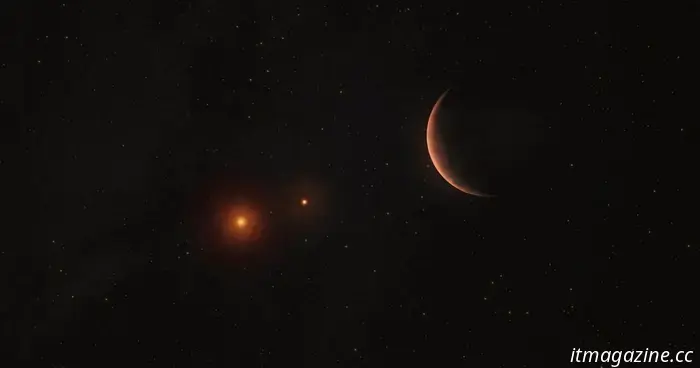
This strange exoplanet revolves around two stars in an unprecedented manner.
This illustration depicts an exoplanet revolving around two brown dwarfs—objects larger than gas giants but too small to be classified as true stars.
Astronomers have identified a remarkably unusual exoplanet: one that orbits its host stars in a completely novel manner. The planet 2M1510 (AB) b orbits two stars—similar to Luke Skywalker’s home planet of Tatooine for Star Wars enthusiasts—but does so in a distinctly unconventional way.
Most planets that orbit two stars do so in a relatively straightforward manner: the two stars move in a ring formation, while the planet orbits in a further-out ring. However, the newly found planet is different. The stars move in a ring structure, and the planet orbits them around their poles. This type of orbit, referred to as a polar orbit, marks the first observation of a planet circling two stars in such a manner.
This is an artist's interpretation of the exoplanet 2M1510 (AB) b’s peculiar orbit around its host stars, a duo of brown dwarfs. The newly discovered planet has a polar orbit, which is oriented at a right angle to the plane in which both stars travel.
Astronomers had hypothesized that such an orbit was feasible, but it had never been witnessed before being discovered with the European Southern Observatory’s Very Large Telescope (VLT). “I am particularly thrilled to be part of the team that has found credible evidence for this configuration,” stated lead researcher Thomas Baycroft from the University of Birmingham, UK.
The star pair orbited by the planet consists of brown dwarfs. Sometimes referred to as failed stars, these entities lie between planets and stars in size, being too large to be classified as planets yet not large enough to sustain nuclear fusion in their cores. This adds to the planet's uniqueness.
“A planet orbiting not just a binary, but a binary brown dwarf, along with being in a polar orbit is truly amazing and exciting,” remarked co-author Amaury Triaud from the University of Birmingham. “The discovery was unexpected since our observations were not aimed at finding such a planet or orbital configuration, making it quite a surprise.”
The researchers deduced that a planet must exist in this system due to the strange motions of the stars, which were influenced by the gravity of the planet. They attempted to ascertain what was causing these stellar motions, and the presence of a planet in this peculiar orbit was the only plausible explanation.
“Overall, I think this demonstrates to both astronomers and the general public the possibilities within the captivating universe we inhabit,” commented Triaud.
The research will be published in the journal Science Advances.
Georgina has been a space writer for Digital Trends for six years, focusing on human space exploration and planetary science.
NASA has released a stunning image of Saturn, recently captured by the James Webb Space Telescope (JWST). Webb’s initial near-infrared observations of the second-largest planet in our solar system also highlight several of Saturn’s moons: Dione, Enceladus, and Tethys.
Anyone who has watched Star Wars might find themselves captivated by the sights from Luke's home planet of Tatooine, with its duo of suns visible in the sky above the desert. As visually striking as this notion is, it is not mere fantasy; planets that orbit two stars, known as circumbinary systems, do exist. If you were on one of these planets, you would witness two stars in the sky. Recently, astronomers uncovered one such planet, labeled BEBOP-1c. Situated in the same system as a previously discovered planet, TOI-1338b, the research team was measuring the mass of the known planet when they stumbled upon the new one. “Only 12 circumbinary systems have been discovered to date, and this is just the second known to host multiple planets,” noted researcher David Martin from Ohio State University in a statement.
Astronomers have found a "forbidden" planet that seems to be disproportionately large given its circumstances. A research team explored a candidate exoplanet named TOI 5205b, initially detected by NASA's Transiting Exoplanet Survey Satellite (TESS), and not only confirmed its existence but also uncovered some perplexing characteristics. An artist's rendition illustrates a large gas giant planet orbiting a small red dwarf star called TOI-5205.






Other articles
 X will eliminate direct messages to create its own messaging platform.
X intends to substitute the DMs section with XChat.
X will eliminate direct messages to create its own messaging platform.
X intends to substitute the DMs section with XChat.
 Amazon has discontinued the Citadel spinoffs Honey Bunny and Diana; season 2 is now set for 2026.
Citadel: Honey Bunny and Citadel: Diana will not be renewed for second seasons on Prime Video. Instead, Amazon will concentrate on completing Citadel season 2.
Amazon has discontinued the Citadel spinoffs Honey Bunny and Diana; season 2 is now set for 2026.
Citadel: Honey Bunny and Citadel: Diana will not be renewed for second seasons on Prime Video. Instead, Amazon will concentrate on completing Citadel season 2.
 JBL Charge 6 review: How a straightforward strap makes it the ideal portable speaker
JBL’s Charge series of portable speakers has consistently been a popular choice for those seeking powerful sound on the go. The reasons for this popularity are clear. Featuring a durable design, a large battery that doubles as a charger for your other devices, and sufficient volume to energize a mid-sized pool party, the Charge is tough to rival. [...]
JBL Charge 6 review: How a straightforward strap makes it the ideal portable speaker
JBL’s Charge series of portable speakers has consistently been a popular choice for those seeking powerful sound on the go. The reasons for this popularity are clear. Featuring a durable design, a large battery that doubles as a charger for your other devices, and sufficient volume to energize a mid-sized pool party, the Charge is tough to rival. [...]
 Spotify outage: service has been restored as Spotify claims that reports of a hack are untrue.
It wasn't only you; Spotify was experiencing outages. On April 16, countless users around the globe reported problems with the well-known music streaming platform.
Spotify outage: service has been restored as Spotify claims that reports of a hack are untrue.
It wasn't only you; Spotify was experiencing outages. On April 16, countless users around the globe reported problems with the well-known music streaming platform.
 Trump's tariffs revive Europe's drive for cloud sovereignty.
According to Mark Boost from CIVO, Trump's tariffs have "solidified the notion" that Europe cannot depend on the United States for its digital infrastructure.
Trump's tariffs revive Europe's drive for cloud sovereignty.
According to Mark Boost from CIVO, Trump's tariffs have "solidified the notion" that Europe cannot depend on the United States for its digital infrastructure.
This strange exoplanet revolves around two stars in an unprecedented manner.
Astronomers have made a peculiar finding: a planet that revolves around two stars at an unusual angle.
